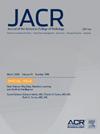在临床应用前为基于成像的人工智能算法建立验证基础设施。
IF 4
3区 医学
Q1 RADIOLOGY, NUCLEAR MEDICINE & MEDICAL IMAGING
引用次数: 0
摘要
随着前景广阔的人工智能(AI)算法获得 FDA(美国食品和药物管理局)许可,在将这些模型纳入常规工作流程之前,必须对其对临床结果的潜在影响进行本地评估。强大的验证基础设施对于检测这些深度学习算法的准确性和可推广性以确保患者安全和健康公平至关重要。受保护的健康信息(PHI)问题、知识产权和模型的不同要求阻碍了严格的外部验证基础设施的发展。我们的工作提出了各种建议,以应对与开发高效、可定制和具有成本效益的基础设施相关的挑战,从而在大型医疗中心和机构对人工智能模型进行外部验证。我们提出了在临床系统外建立人工智能推断基础设施的综合步骤,以便在医疗实践或全系统实施之前检查人工智能算法的本地性能,并推广基于证据的方法,以采用可增强放射学工作流程并改善患者预后的人工智能模型。本文章由计算机程序翻译,如有差异,请以英文原文为准。
Establishing a Validation Infrastructure for Imaging-Based Artificial Intelligence Algorithms Before Clinical Implementation
With promising artificial intelligence (AI) algorithms receiving FDA clearance, the potential impact of these models on clinical outcomes must be evaluated locally before their integration into routine workflows. Robust validation infrastructures are pivotal to inspecting the accuracy and generalizability of these deep learning algorithms to ensure both patient safety and health equity. Protected health information concerns, intellectual property rights, and diverse requirements of models impede the development of rigorous external validation infrastructures. The authors propose various suggestions for addressing the challenges associated with the development of efficient, customizable, and cost-effective infrastructures for the external validation of AI models at large medical centers and institutions. The authors present comprehensive steps to establish an AI inferencing infrastructure outside clinical systems to examine the local performance of AI algorithms before health practice or systemwide implementation and promote an evidence-based approach for adopting AI models that can enhance radiology workflows and improve patient outcomes.
求助全文
通过发布文献求助,成功后即可免费获取论文全文。
去求助
来源期刊

Journal of the American College of Radiology
RADIOLOGY, NUCLEAR MEDICINE & MEDICAL IMAGING-
CiteScore
6.30
自引率
8.90%
发文量
312
审稿时长
34 days
期刊介绍:
The official journal of the American College of Radiology, JACR informs its readers of timely, pertinent, and important topics affecting the practice of diagnostic radiologists, interventional radiologists, medical physicists, and radiation oncologists. In so doing, JACR improves their practices and helps optimize their role in the health care system. By providing a forum for informative, well-written articles on health policy, clinical practice, practice management, data science, and education, JACR engages readers in a dialogue that ultimately benefits patient care.
 求助内容:
求助内容: 应助结果提醒方式:
应助结果提醒方式:


